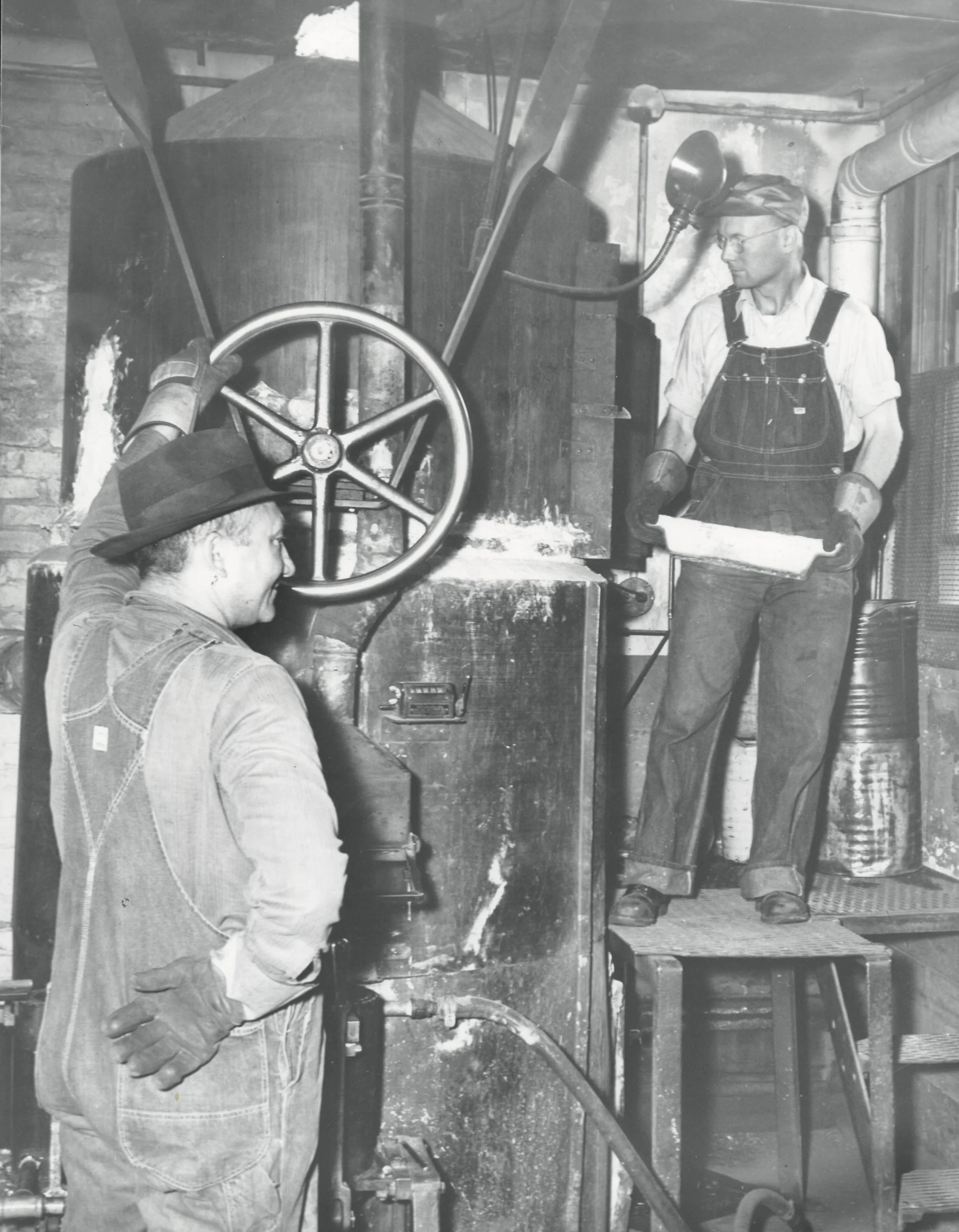How the plant looked in 1924: On left, Carl Barstow; seen between the two vertical straps, Elmer Olson; just behind Elmer near the brick, John Haller; center, back, near the window, Clyde Erickson; wearing black near the wall, Rip Livgard; bending slightly, near Rip, Herman Ridge; back right are two men, George Humphries and E. Olson; front right with his foot raised, Elmer Johnson. (Monark, April 1972, p. 23)
Celebrating 100 years of community, connection, and care
1922-2022
In many ways, the Anoka County Historical Society has grown up alongside Federal Cartridge Company—they celebrate birthdays only 12 years apart—sharing the same town of Anoka, Minnesota as community touchstones steeped in legacy of their own making. Like many nonprofits and businesses in Anoka, FCC maintains a generous partnership with ACHS, helping the organization grow. The trust, built through time, led to the centennial donation of 100 years of documents, photos, live images, and framed objects to the history center.
It’s difficult to accurately express the number of items in the collection—there’s 25 boxes of printed images alone—that have travelled through our archival process. From high-level “weeding” to sorting by decade and name, down to digitizing, labeling, and data entry into our online program, the FCC collection challenged our small museum’s resources. Now that it’s complete, available to the public at AnokaCountyHistory.org, we can move ahead to creating a physical exhibit at our history center as well as an online exhibit.
We invite you to visit either (or both!) repositories to appreciate more the legacy of Charles Horn, Robert Ehlen, their thousands of employees, and the impact FCC all had on not only Anoka as a city, but the United States as a whole. Through wars, economic changes, political crisis, and labor shifts, FCC supported its staff and the community, making itself relevant.
The physical exhibit will open in time for the actual 100th anniversary of FCC, June 2022. This display will include original documents signed by Horn, notes in his nearly illegible scrawl, and of course, his signature carnation laying on the desk. Visitors will experience one-of-a-kind blueprints for machinery and shells, an array of advertising, a full collection of The Monarch publication, and framed images of the factory. You’ll hear the experience of plant employees, some of whom have logged 600 years of combined service to FCC as a family group. Best of all, you can contribute to the next century of history by leaving ACHS your own story and experiences with Federal ammunition, as an employer, or as a community partner.
A centennial birthday only comes around once in, well…100 years. We’re lucky enough to witness this milestone, poised between a legacy of the past and the possibilities of the future. Celebrate with FCC and ACHS while learning more about the people who built the corporation we know today. Without the thousands of employees who clocked in for their shift, joined the company bowling league or choir, sponsored the picnics or brought treats for the children at the holidays—without the community of Anoka, Minnesota embracing Horn’s ideals—FCC would look significantly different today. But they did. That’s the story we get to tell.
Lead melting for .22 wire (Object ID FCC2020.0533.02.017-A)
timeline
1916- Louis and Harry Sherman began construction on Federal ammunition plant.
1922- The Federal Cartridge Company was incorporated with Charles L. Horn as president and John Haller overseeing daily operations.
1924- Began production of .22 rimfire ammunition
1925- Franklin W. Olin, founder of Western Cartridge Company, became a primary stockholder at Federal.
1930- Robert B. Ehlen became manager of the ammunition operations.
1932- Franklin Olin gains control of Federal Cartridge Company but Charles Horn remains president.
1935- Charles L. Horn secured a contract with the United States government to build and operate the Twin Cities Ordnance Plant in New Brighton, Minnesota with Robert B. Ehlen managing the plant.
1941- Construction of the Twin Cities Ordnanace Plant began in August.
1945- The government contract was terminated after having produced more than 5 Billion rounds of ammunition compared to the 100 million rounds initially requested in the contract.
1950- The Twin Cities Ordnance Plant is reactivated for the Korean War, providing Federal with the opportunity gain knowledge on the production of handgun and rifle ammunition.
1963- Federal adds handgun and rifle ammunition to their catalogue for the first time.
1965- The TCOP was reactivated once again for the Vietnam War and Federal introduces the first colored plastic shotgun shell hulls.
1974- Charles L. Horn stepped down as president of Federal and became chairman of the board. His son William Horn became president of the company.
1977- Charles L. Horn retires from Federal Cartridge Company after 55 years.
1985- The Olin Foundation who had owned the company since 1938 sold the company and it became known as Federal-Hoffman Incorporated.
1988- Federal-Hoffman Incorporated was purchsed by Pentair Incorporated and Ron Mason became the company’s third president in its 66 year existence.
1992- Federal’s Gold Medal UtraMatch .22 rimfire ammunition became the first American-made load to win an olympic medal since 1960.
1997- Federal was sold again to Blount Industries for 112 million dollars.
1999- For the fifth time in its history Federal was sold, this time to Lehman Brothers.
2001- Federal was purchased by a Minnesota-based aerospace and defense company Alliant Techsystems (ATK).
2015- ATK created a spin off company called Vista Outdoor with Federal as one of its flagship brands.
2018- Jason Vanderbrink appointed ammunition president of Vista Outdoor and innovation contiued to roll out the most new products in the company’s history.
Digitized Federal Cartridge Film
Playlist:
A Federal Case - A plant tour from the 1960s
The Story of Trapshooting
A Federal Picnic from 1940




